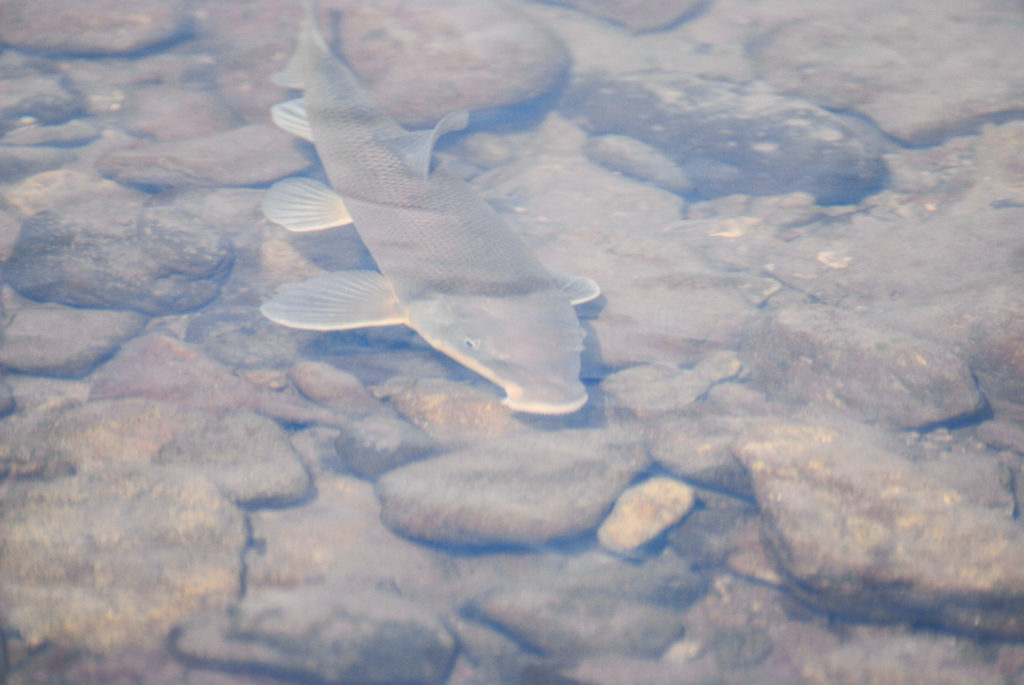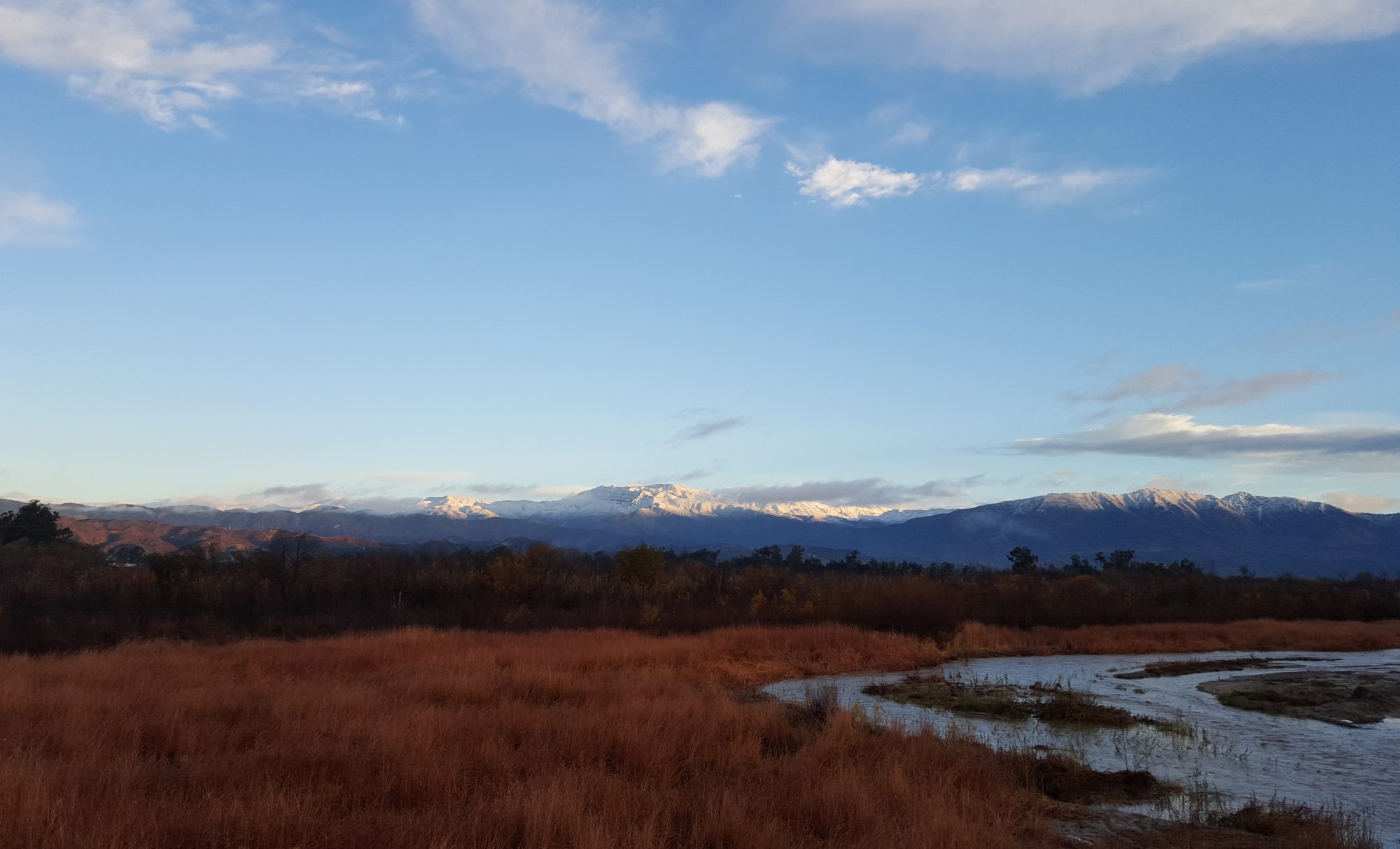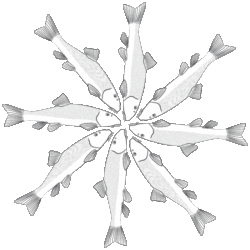
Our work in desert fishes has several dimensions: 1) describing movement patterns of fishes at the habitat scale on a daily basis and longer term movements at over within and between seasons, and 2) understanding how the ecological engineering activities of suckers influences habitat hetereogeneity.
Sucker movement
Small scale/short term movements
Movement of organisms is an important mechanism controlling an array of processes within ecosystems. Recent analyses suggest that movement is composed of individual displacement (distance moved by individuals) and turnover (proportion of individuals moving). Turnover of individuals is important because it influences population size and structure, as well as interactions among individuals and different species within a habitat. We used stationary antennas and passive integrated transponders tags to monitor individual habitat use, turnover, and displacement of Sonora suckers (Catostomus insignis) and desert suckers (Catostomus clarkii) in the West Fork Gila River, New Mexico, USA. Many tagged fish used our focal stationary antenna reach, but only a subset was consistently present. Population size and turnover rates were variable from day to day. Although some individuals spent the majority of their time within the focal reach, most made extended departures (one or more days) from their home pools. Many individuals displayed fidelity to a particular habitat despite forays elsewhere, returning to the focal reach throughout the study. Diel or short-term movements may explain high turnover rates typically observed and, combined with high site fidelity, may result in the misclassification of individuals as sedentary, despite frequent, potentially short-term, movements into other habitats.
Read more:
Booth, M.T., Hairston, N. G. Jr., Flecker, A. S. How mobile are fish populations? Diel movement, population turnover, and site fidelity in suckers. 2013. Canadian Journal of Fisheries and Aquatic Science. 70(5):666-677. Download full text
Large scale and seasonal movements
Fish populations are composed of a mixture of sedentary and mobile individuals, but it is not clear whether movement behavior is plastic or fixed for individuals and what proportion of the population exhibits mobile behavior. To investigate the mobility and movement patterns of two common species of suckers, the Sonora Sucker Catostomus insignis and the Desert Sucker Catostomus clarkii, in the Gila River of western New Mexico, we tracked 449 individuals over three summers using passive integrated transponder (PIT) telemetry. Both species were mobile and the typical linear home ranges for mobile individuals exceeded 150 m, but approximately 25% of individuals were detected only in a single habitat segment. We observed increased movement after spates caused by summer monsoon rains, and fish used areas of the stream differently under high- and low-flow conditions. Fish moved farther between years than within years, but a subset of individuals were found in the same locations from year to year. For the study species, movement behavior does not appear to be a fixed trait for individuals, and many individuals exhibited both stationary and mobile behavior among years. We also investigated whether sample size biased the estimates of movement parameters. We concluded that movement parameters would be underestimated by 20–50% if we had tracked fewer individuals, but the degree to which the parameters were biased varied from year to year.
Read more:
Booth, M.T., Hairston, N. G. Jr., Flecker, A. S. Is mobility a fixed trait? Summer movement patterns of catostomids using PIT telemetry. 2014. Transactions of the American Fisheries Society. 143(4):1098-1111. Download full text
Ecological engineering role of suckers
Spatial and temporal heterogeneity can be important components of ecosystem structure with the potential to modify ecological dynamics. Ecosystem engineers can control the spatial and temporal distribution of resources and movement by engineers within an ecosystem may transport resources across boundaries and distribute engineering effects. Movement patterns of fishes may cause physical changes to stream habitat though nesting or feeding, both of which often vary in space and time. The timing and location of movement patterns can control heterogeneity in benthic substrates and in sediment and carbon export resulting from ecosystem engineering by the Sonora sucker (Catostomus insignis), a dominant fish in streams of the southwestern United States. Sonora suckers exhibit distinct diel movement patterns, spending daylight hours in refuge habitats (typically deep pools) while moving into shallow habitats at night to feed. Feeding by suckers creates disturbance in soft sediments that are patchy in space and time. These disturbances move up to 2.4 x 104 cm3 of sediment per square meter per week in locations that are up to hundreds of meters away from sucker daytime refuges. The diel cycles in feeding activity (i.e., nocturnal digging in benthic substrates) caused pulses in suspended sediment that comprise up to 34% of the daily suspended load of a stream reach. Our data indicate that movement by ecosystem engineers can modulate their effects in space and time with implications for heterogeneity in the distribution of resources.
Read More:
Booth, M.T., Hairston, N. G. H., Jr., Flecker, A. S.. Consumer movement dynamics as hidden drivers of stream habitat structure: suckers as ecosystem engineers on the night shift. 2020. Oikos. 129: 194-208. DOI: 10.1111/oik.06396 Download full text

